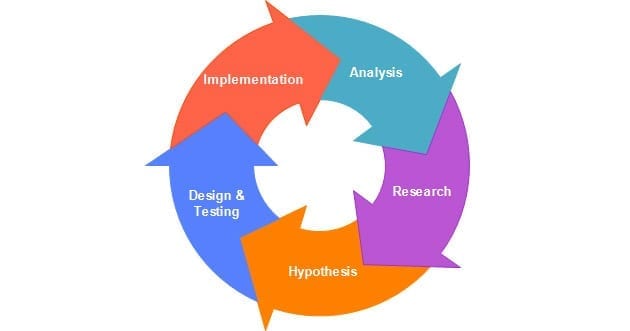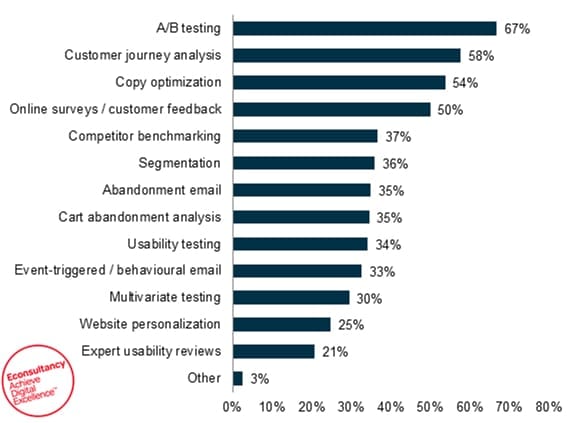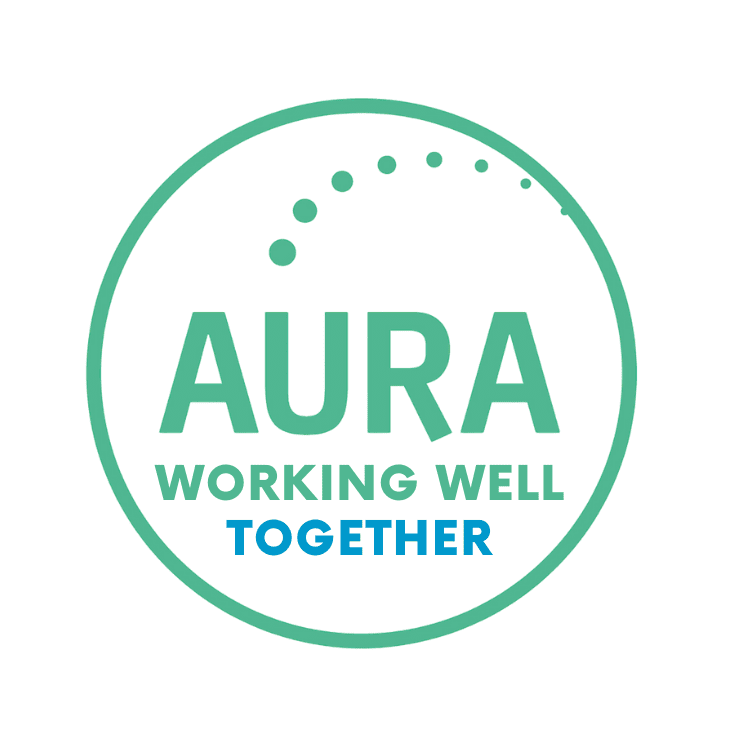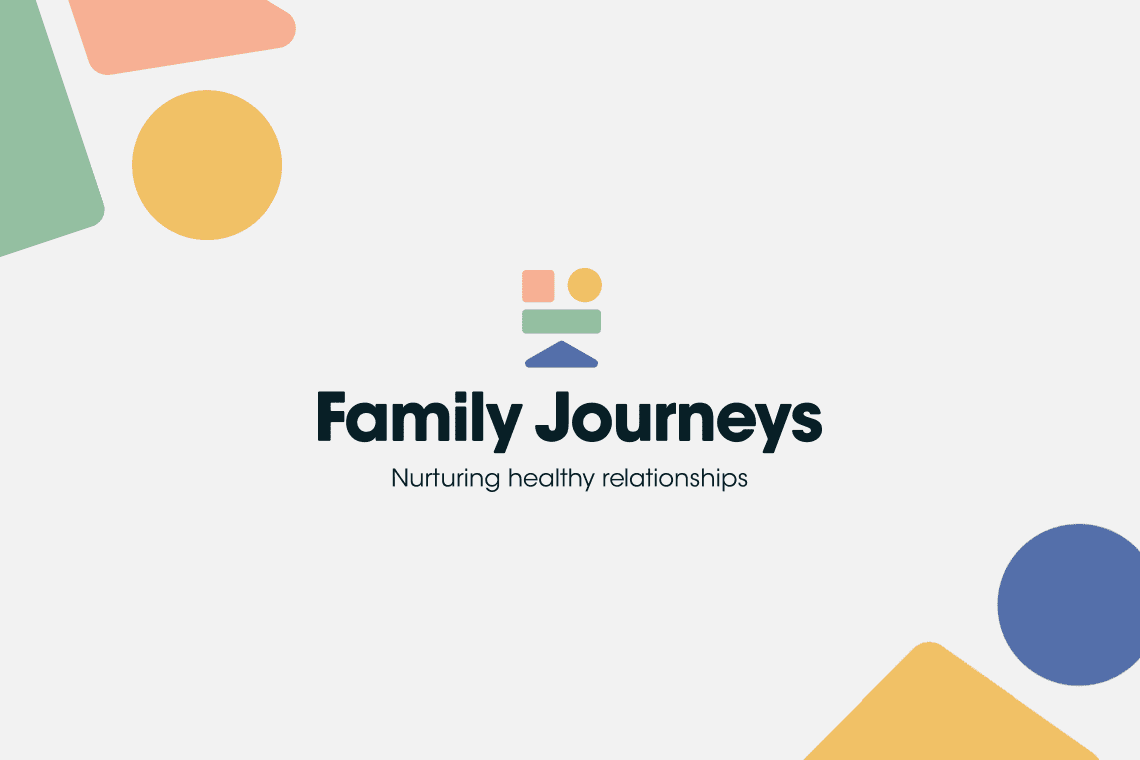The average ecommerce website conversion rate for big retail brands is between 2 and 3%. Recent research from Adobe seems to back this up.
The conversion rates for lead generation websites differs widely dependent on the business sector. For instance MarketingSherpa estimates, that the average website conversion rate not-for-profit websites is around 2% whereas for financial services it’s 10%.
What is conversion rate optimisation?
Conversion rate optimisation (CRO) is a process used to increase the percentage of visitors that complete a specific task or action. Generally, this relates to financial or data transactions but what that task or action is, doesn’t really matter. It could be:
- Completing an online purchase
- Successfully submitting a form
- Downloading a document
Even though CRO is a fairly recent digital marketing term. It’s based on a well-established established process: user centred design.
Conversion rate optimisation isn’t just testing the text and colours of your buttons. It also goes well beyond the scope of an expert usability review or a one-off round of usability testing. It’s a process that uses a number of different techniques to affect a measurable improvement.

Research from eConsultancy highlights most of the methods and techniques used to improve conversion rates:


In fact, according to eConsultancy, business that use a number of different techniques have seen more progress than those that have not. What’s more specific combinations have led to higher success rates:
Of the companies that used customer journey analysis, copy optimisation and segmentation, 95% saw an improvement in their website conversion, compared to an average of 72% among other respondents.
It’s worth point out that this may be down to frequency as much as anything else. After all each test will lead to different results (irrespective of the technique used). So, by using more techniques you’re doing more testing which allows you to uncover more issues and opportunities to make more informed changes.
As eConsultancy themselves point out:
It should almost go without saying, but companies that test more often derive greater rewards from their activities. Companies that saw a significant increase in their sales conducted 6.45 tests per month, compared to just 2.42 tests among organisations that saw their sales decrease.
This really reiterates you should only consider implementing a CRO process if you have the resources to:
- Sustain it over the course of 6-12 months
- Run at least 1 test a week
What are the blockers to CRO?
Sometimes it’s the business’s that have the most to gain that seem the most resistant to CRO. Why? I think in large part it’s because they’re already successful and still growing, albeit slower than they’d like.
So, their biggest issue is why run the risk of (in reality quite substantial) change(s). Which is totally fair enough – there’s no guarantees with CRO and you’ve got to do different to get different. And if anyone tells you otherwise, they aren’t telling the truth, it’s as simple as that.
The other common issues we’ve come across are:
Lack of budget: which leads to “I just want a report”. Or in other words “I’m not paying a consultant that much for that long to bother our customers and play around with our website” or “test, you should know given how much you’re charging me”. Some people just hate the concept of investing in a (continuous improvement) process as opposed to a deliverable that promises a one-off lift, that may, or may not be attributable to the work conducted.
Measuring the wrong thing: they’re focussed on traffic and/or are measuring the vanity metrics as opposed to meaningful KPIs. This is a misnomer as Forrester Research estimates that:
“for every $100 spent on driving traffic to websites, companies spend just $1 converting that traffic into business.”
How do you kick off an effective CRO process?
As I said, a robust conversion rate optimisation process will use a number of different user centred methods and techniques. The one’s selected will be wholly dependent on the:
- Activities already being conducted in-house
- Objectives you’ve been tasked with achieving
- Scope of your remit
- Access to qualitative and quantitative (customer and sales) data
- Access to and buy-in of internal staff
- Constraints you have to work within (time and budget)
That said, you can’t improve something unless you know:
- What you need to improve (prioritised objectives with specific measurable targets associated)
- How to measure improvement (Key Performance Indicators)
- Where you’re starting from (your baseline)
That’s why every CRO project we’ve worked on has involved most if not all of the steps detailed below. If you don’t get meaningful inputs off the back of completing these steps, I’d strongly recommend that you reassess whether or not this is an engagement you can take on. As without capturing the inputs detailed below its nigh on impossible to contribute to a meaningful impact that you’ll be able to rationalise and explain.
What does a CRO process look like?
1. Understand the business
Identify the company’s:
- Goals and strategic plans
- Unique selling points or unique value proposition
- Existing customer segments and their specific research and purchasing processes
- Sales process by product or service
- The level of buy-in from other departments and their willingness to engage with the process
2. Assess the touch point you’ve been tasked with improving
- How the website is currently performing
- How the website has performed historically
- The website’s (current) sales funnel
- The traffic the website currently receives
- Identify any issues that are preventing people from buying (usability)
- Identify any issues that are likely to lead to objections or anxiety on the part of an end-user (messaging)
3. Define the objectives you’ve been tasked with achieving
To prove that this is a robust process you need to ensure there’s a shared understanding of the objectives you’re being engaged to achieve. In our experience you need to work closely with project stakeholders to:
- Think globally in terms of what we’re trying to achieve (what are the underlying outcomes the business needs to achieve)
- Brainstorm objectives
- Prioritise these
- Define SMART objectives
- Translate these into KPIs that can be tracked and measured
It may be worth drafting a short list of principles that will guide your efforts too. Although this is a purely optional step it can be useful for reaffirming the key principles that you are hoping people will adopt in-house.
It is absolutely critical that you share this finalised output with everyone involved in the process. As this is the only way to align the disparate people, who all have their own day-to-day priorities and responsibilities, you’ll need onside throughout the process.
4. Analyse direct competitors
Competitor analysis, when overlaid with qualitative research from website visitors and customers, can help identify opportunities to establish a competitive advantage.
Yes, every website is different but that doesn’t mean you can’t learn a lot from your competitors. Each and every one of them will do things differently. It’s important to audit their approaches so that you can learn from their successes and mistakes.
5. Expert review or cognitive walkthroughs
This is a critical step in which you attempt to use the website as an end-user. You only get to do this once. As the more you find out about a business and use their website, the further and further you’ll be from the mental model of a typical user.
Although neither of these methods are as effective as usability testing in terms of finding “can’t buy” issues. This approach can still help you go beyond the scope of what you can achieve with usability testing. It enables you to cover each and every element of a website, whereas the cost implications of usability testing generally means this is confined to one or two key user journeys.
Learn more about expert reviews by reading this post.
6. Test your tracking tools
Before you kick-off testing run an A/A test (where you test your A page against itself, not a version that contains any variations). As this will ensure your web analytics and A/B testing tools are set-up correctly and generating accurate data. It’s not uncommon for A/B testing software to generate inaccurate results so this step is vital.
7. Review web analytics data
The web analytics data will help you understand what people are doing on your website. If you do not have an analytics measurement model in place then now is the time to define one. This will help you focus on the data that matters.
Once you’ve got your head around this it’s time to start looking at:
- What types of pages the website has (profile them in terms of how are people’s likely to behave when they land on them; is it an entry page, an info page, a conversion page, etc)
- Pages with high/low exit rates
- Pages with high/low bounce rates
This is just the start! Segmenting the data at your disposal is so important to uncovering insights. But the point is you need to analyse the data at your disposal with the aim of understanding the intent of visitors (per page or referring source) and identifying why pages (or key user journeys) are or are not performing
8. Review search data
Your search logs are a treasure-trove of customer insights. Analyse what people are struggling to find on your website to identify the language they use as well as any content or navigation issues you should be investigating further.
9. Review other data at your disposal
It is critical that you collaborate with departments across the business. Ask them to share the data that they collect (sales, operations, support, etc). This is particularly important if you work in a large organisation that’s departments are structured by channel, e.g. Mobile, Online, In-branch, etc.
10. Survey visitors (those who don’t buy) and customers
Attempting to understand your visitors (especially those who don’t buy) is a critical part of a robust CRO process.
After all you can’t address the problems people encounter or their reasons to say no unless you first identify what:
- Visitors wish to accomplish by using your website
- Reasons that influenced them to convert
- Objections that were successfully overcome
- Objections and problems that prevented people from converting
- The language that they use to describe or look for your product or service
Capturing this information has never been easier or more cost-effective. If you’re prevented from completing this step then you’re going to struggle to generate the insights you need to really nudge the needle.
Remember you need to keep collecting data too.
What your customers think, feel and do will continuously change. Qualitative research can provide you with rich insights. But you’ve got to remember this is just a snapshot in time. The very same people may have very different views by the time you’ve responded. So, you need to implement a process that ensures your leveraging timely and relevant data.
11. Segment user’s
The purpose of this process is not to highlight arbitrary differences between your customer segments. What benefit does that bring? What’s important is to identify and highlight the differences that actually affect buying behaviour? Think in terms of the specific factors that stimulate each customer segment to buy. For example, how much time do they have to make a purchasing decision, what does their research and purchasing process look like, etc.
How you do this will be wholly dependent on your business and the customers you wish to reach and convert. That said, the one thing I’d urge you to do is go beyond segmenting users by your product line (e.g. current accounts, saving accounts, personal insurance, etc) and demographics. Think about more meaningful ways in which you can segment your customers by behaviour.
Once you’ve done this you need to drill into their specific needs, issues and research and purchasing process. As this is likely to differ substantially per segment.
12. Usability testing
The quickest, and sometimes most substantial, wins on a CRO project relate to addressing usability issues that prevent users from completing a purchase.
The best way to find these is to observe real-world visitors or customers using a website. We’re big fans of remote usability testing due to time and cost savings it offers over on-site testing. The recent emergence of tools that make it affordable to record real-world visitor sessions have also proved invaluable.
Put simply, if you have the resources to conduct usability testing – do it! If you don’t, see if you’ve got the resources to conduct some remote usability testing, it’s far cheaper. I guarantee that if you’ve not done this before, (and the tests are run in the right way – which is a skill but it isn’t rocket science) you won’t regret it. As seeing people’s pain and quantifying the cost of this in terms of lost sales or leads) when they use your website is one of the best ways to get internal buy-in for change.
If you can’t do usability testing then default back to lower cost techniques such as an expert review.
13. Customer journey analysis
This is absolutely critical to an effective CRO project. Why? Because so much of why a web page or website is failing to perform is due to a disconnect between a visitor’s intent and the actions a business wishes them to take.
To address this, it is absolutely critical to go beyond your website and think about how each and every customer segment is likely to interact with your company throughout their research and purchasing process.
It’s also important to remember that your website may not always be the point at which a person is converted. So, it’s worth thinking how you can attribute whether or not the website positively or negatively influenced a purchasing decision too.
Learn more about the benefits and process of customer journey mapping.
14. Media and campaign analysis
This is very similar to the above. You need to analyse each and every campaign you’ve run and try to identify what has worked and what has not. For example, for a pay per click (PPC) campaign look at:
- The copy in-use per ad
- The target or destination page it is linked to
- Whether or not any visit attributed to this campaign leads to repeat usage
- If and how you can attribute an eventual conversion to a visit stimulated by a PPC ad
This sounds difficult and it is. But it isn’t impossible and you really need to do this to minimise the risk of jumping to the wrong conclusion.
For instance, a few years ago, I was working on a project for a high-ticket and high-touch service that killed what looked to be a failing print campaign. It was generating plenty of traffic but they were only spending a few seconds on the page prior to abandoning the website. Well that’s a sure sign that page wasn’t working we thought.
Little did we know that in actual fact this highly targeted print campaign was working brilliantly, it just contained a silly mistake. Someone had forgotten to include a phone number. This meant anyone who was interested in learning more about this service had to visit the website to find a phone number.
Given the service being sold they didn’t want to fill out a form, in fact they didn’t want to share their personal details until they’d spoken to someone and had a few key questions answered first. So, what we originally thought was a failed campaign or problem page was in actual fact a “false alarm”. This was confirmed when telephone sales teams started to ask prospects what had prompted their call, and for this segment in particular the print ad was cited time and time again.
This experience taught me a valuable lesson. Even when data is telling you something, does it match what you’d expect to happen given what you know about the type of product or service you sell, and the specific types of people that tend to buy it.
Objective-led changes and variations
Once you’ve completed the steps detailed above you should have a substantial range of problems and potential solutions.
We always recommend that you turn these into hypotheses that can be tested. For example, we use the following as a starting point for any experiments we wish to run:
We believe that [doing this/creating this product]
for [these people]
will achieve [this outcome].
We will know this is true when we see [this market feedback, quantitative measure, qualitative insight].
Once you’ve developed your hypotheses it’s time to prioritise them and develop a test plan for each experiment you wish to run. This should clearly articulate:
- What are we testing? (problem/solution)
- Who are we testing? (specific customer segments)
- Where are we testing? (page types, ID’s)
- How are we testing? (methodology)
- How will we measure success? (quantitative or qualitative measure)
For further information on problem statements and hypotheses testing we’d highly recommend Lean UX: Applying Lean Principles to Improve User Experience.
Once you’ve done this, you’re ready to start your experiment(s) and reporting your findings.
How to maximise the impact of CRO?
Over the years we’ve learnt that how you position and sell user centred design and in turn conversion rate optimisation is key to a truly productive engagement. In fact, the most effective CRO processes we’ve contributed to have now been adopted as an on-going internalised business process. In these companies ensuring traffic is converting effectively is now seen as a higher priority than generating more traffic.
That’s why we thought it would be useful to share a few truisms that are worth bearing in mind prior to suggesting, commissioning or implementing a conversion rate optimisation process:
Purchase a process not a report:
commission a process that delivers insights that inform the variations and test plans you implement. The reports are simply a deliverable, it’s all of the work that informs these that you’re truly paying for.
Align people from the outset:
around the concept that a CRO process is about learning what works best for your customers. This will evolve over time. So, what works today may well not work in the future. This is why continuous testing and analysis is required.
Big changes will result in big changes, and some will not be positive:
learning what works best for your customers will require experimentation. But adopting this approach will turn small failures into big learning points.
Big lifts or spikes will eventually dissipate:
over time you’re highly likely to see short-term increases tail off. Once again this highlights the need for continuous improvement (even if it is incremental) as opposed to one-off projects.
Don’t just focus on customer acquisition or top-line turnover:
you can commission a CRO project to increase any number of different things such as customer lifetime value, average order value, order frequency or even email sign-ups. CRO can be applied to micro-conversions (e.g. signs up for newsletter, refers a friend) as well as macro-conversions (e.g. revenue or lead generation related). Although you should always focus on the macro, unless there is a sound business case to invest in increasing micro-conversions.
Conversion rate isn’t everything:
sometimes you can make more money by reducing your conversion rate, e.g. increasing your prices. Go beyond conversion rates and think about the impact and business outcomes you wish to deliver.
Closing thoughts
The reality is, most websites could drastically improve their conversion rates. For some, the opportunity/cost isn’t worth it. For others, the rewards can be staggering.
Unfortunately, no website is the same and no user is the same. The key to success, is having an intimate understanding of your specific users. After all people are influenced by a wide range of things before they convert. Some you can influence, e.g. the usability of your website, the relevance of your content and the effectiveness of your cross-channel marketing and sales experience all matter. Some you can’t, e.g. perception of an industry sector, the seasonal nature of sales, environmental factors, etc.
So, the key, where possible, is to understand what impact each of these factors has. Only then can you create strategies to reach and successfully convert different customers at different stages in their research and purchasing process.
Interested in implementing a conversion rate optimisation?
Get in touch to learn how we’d approach achieving your business objectives.


